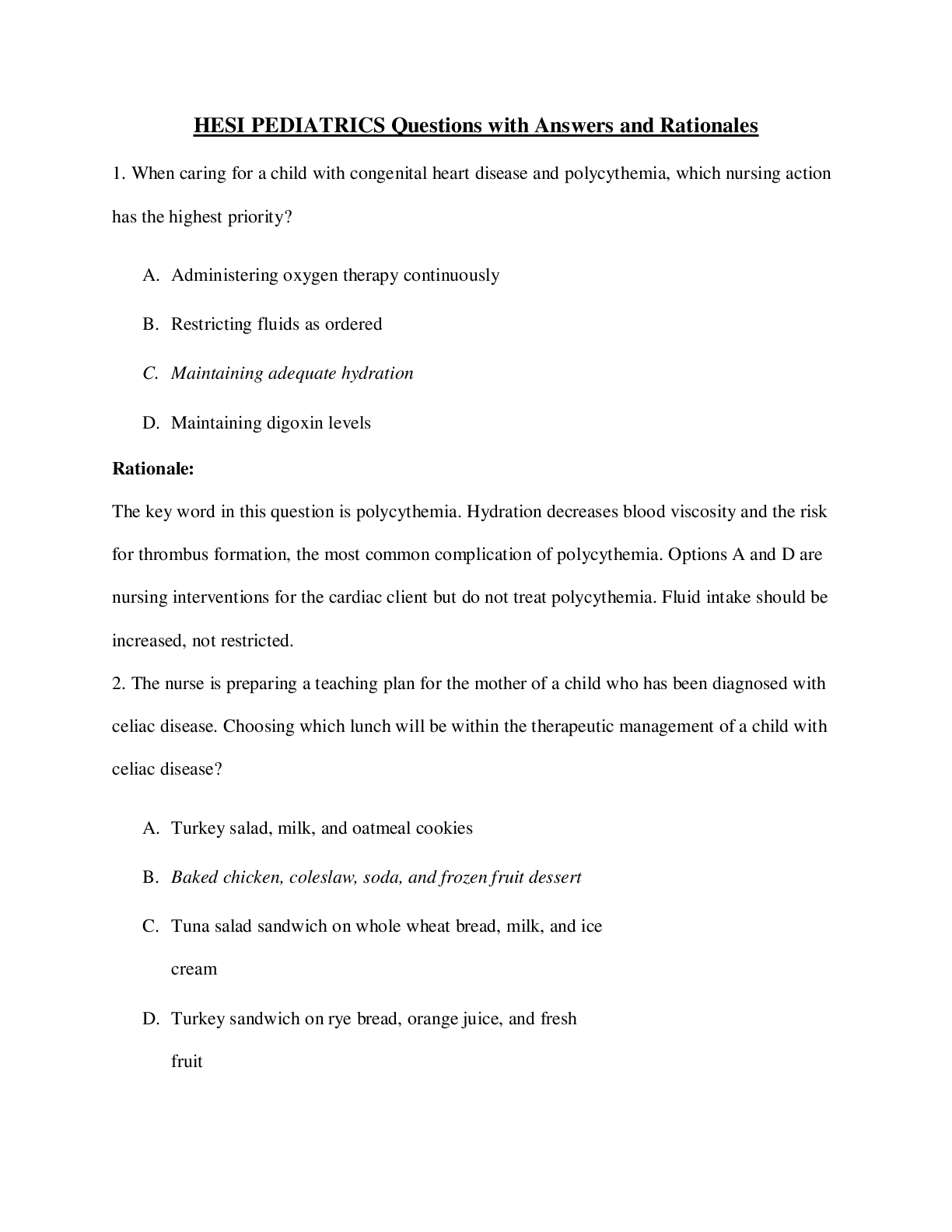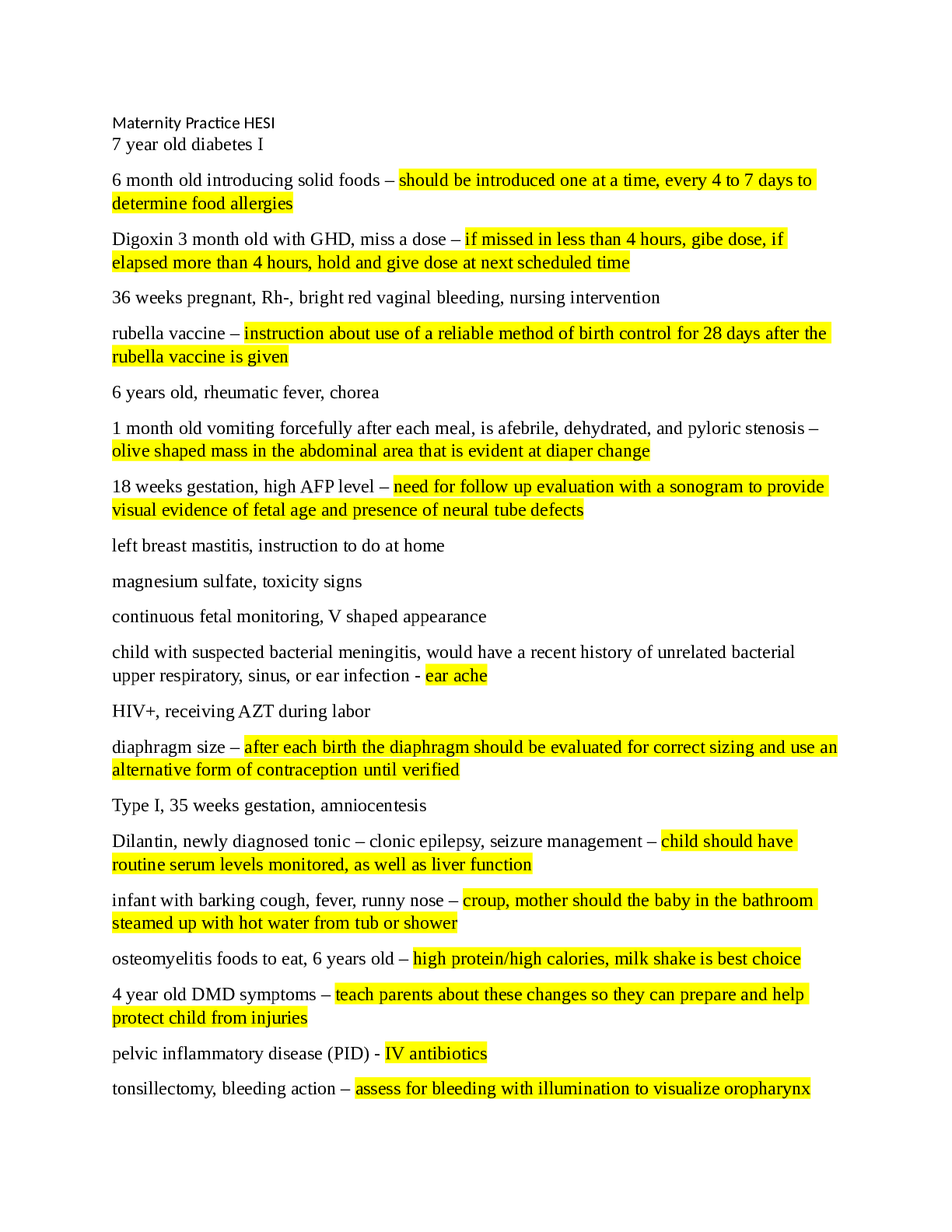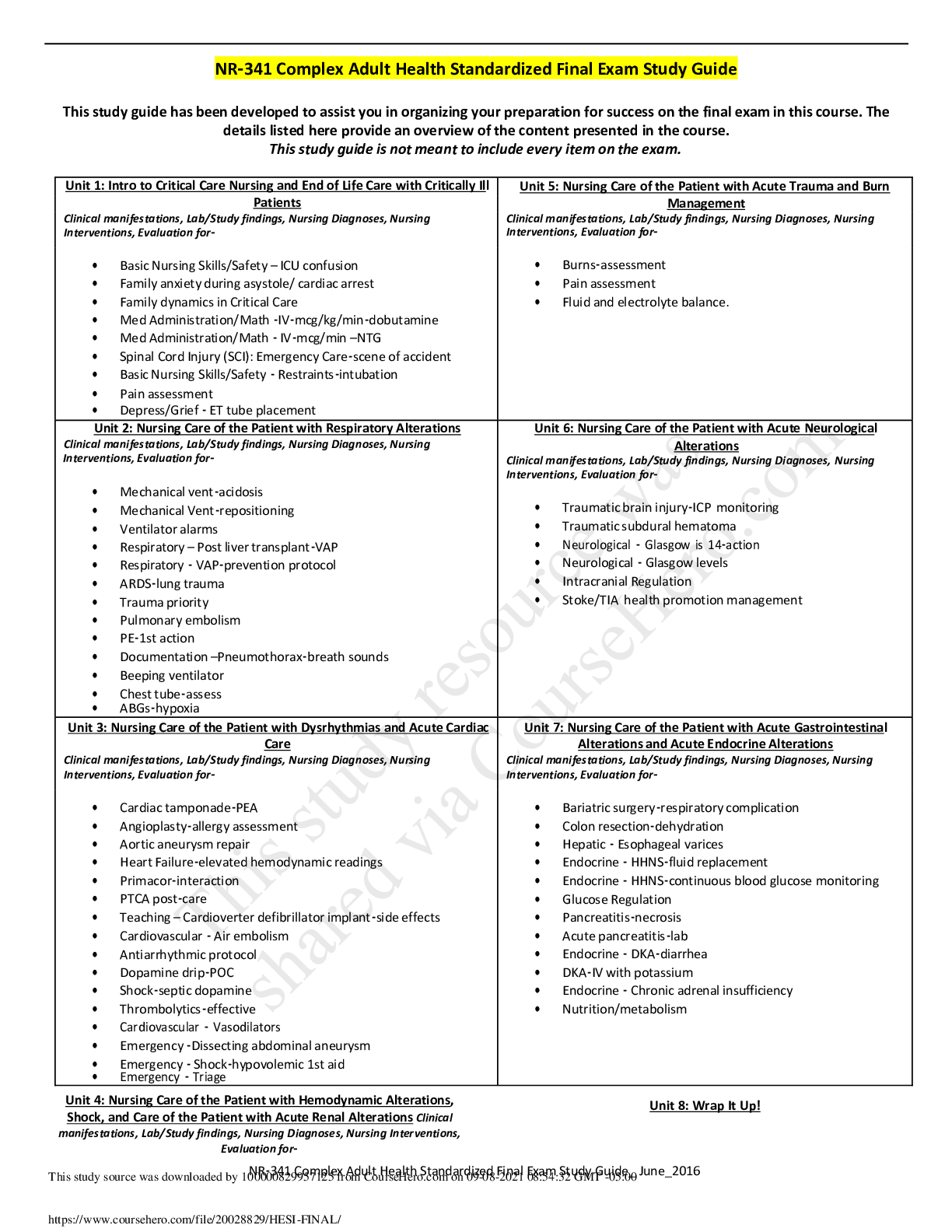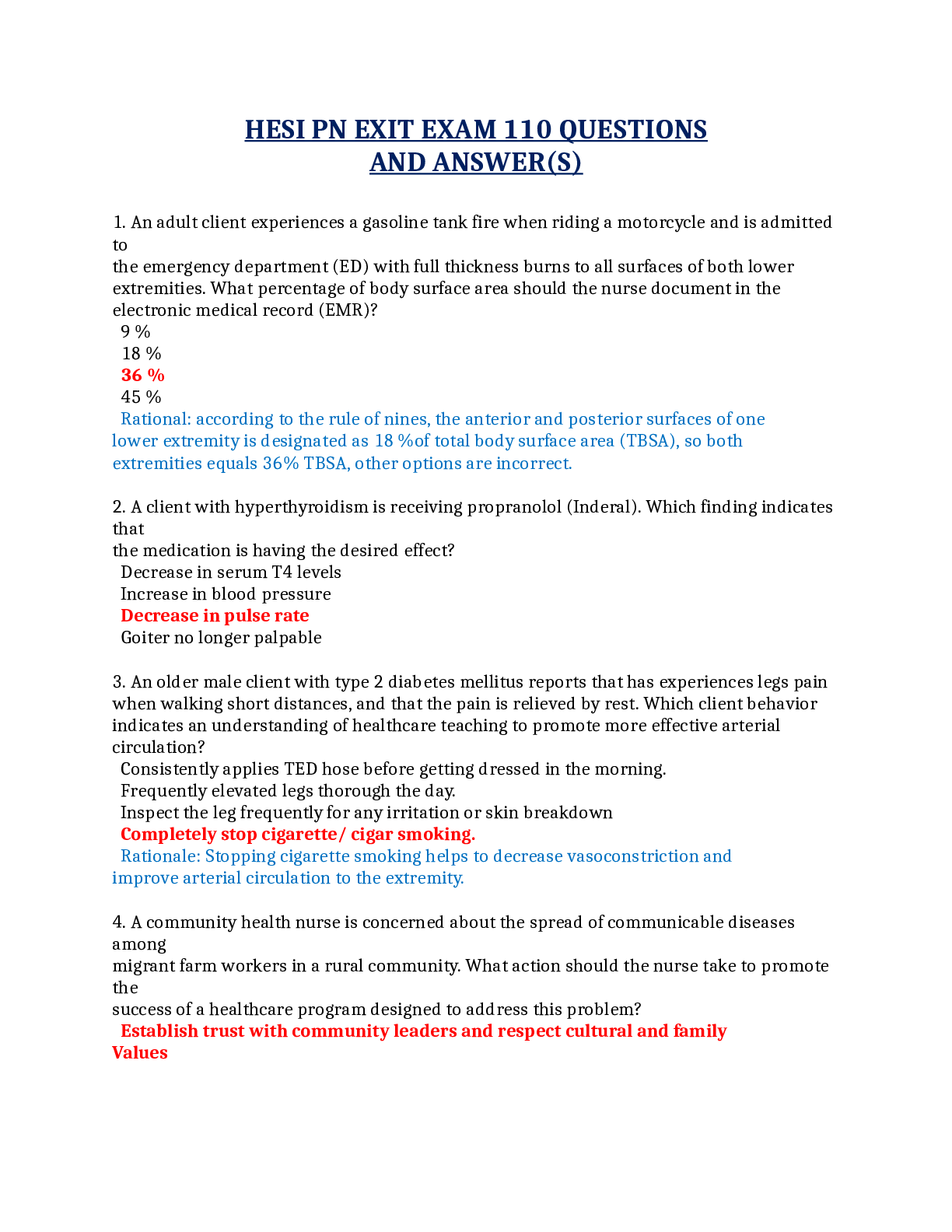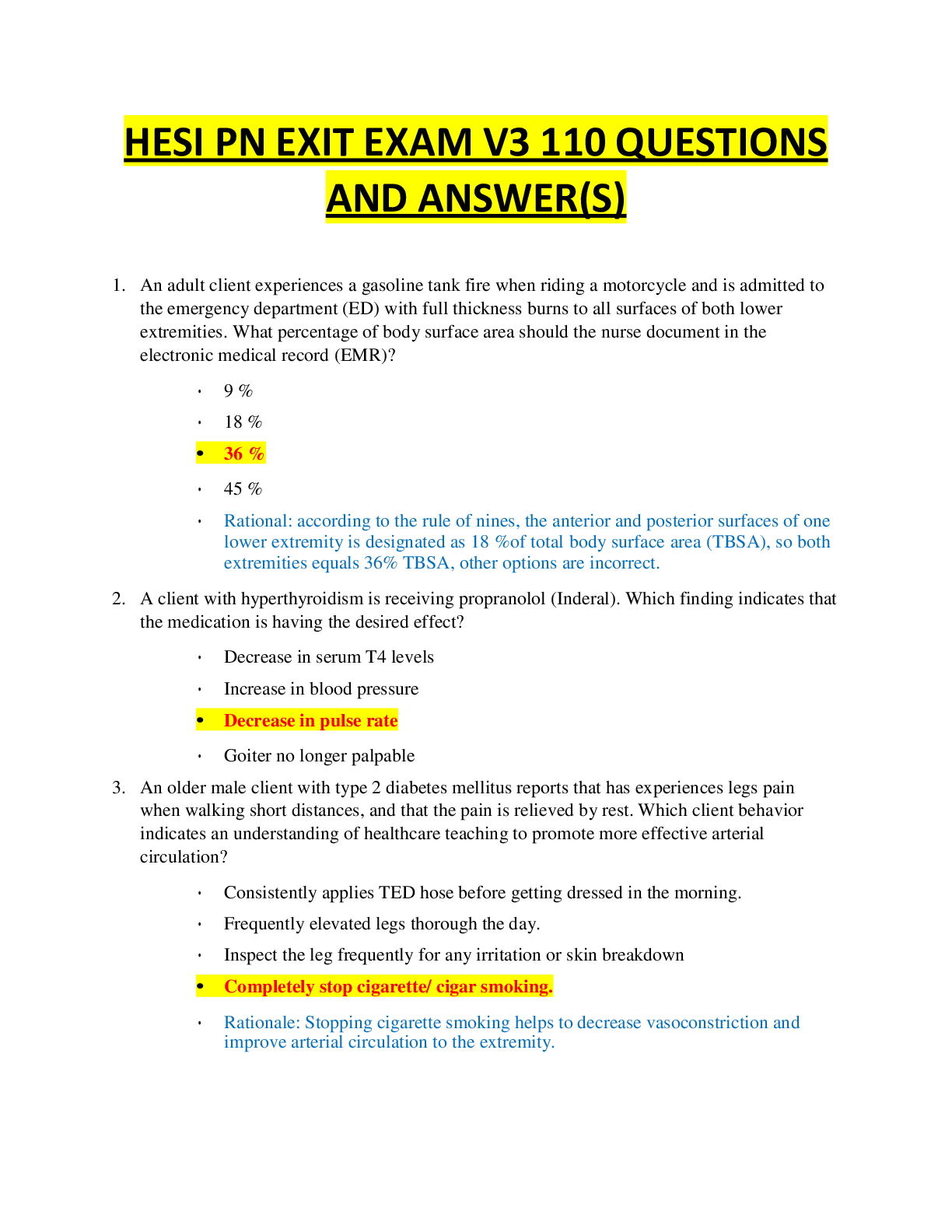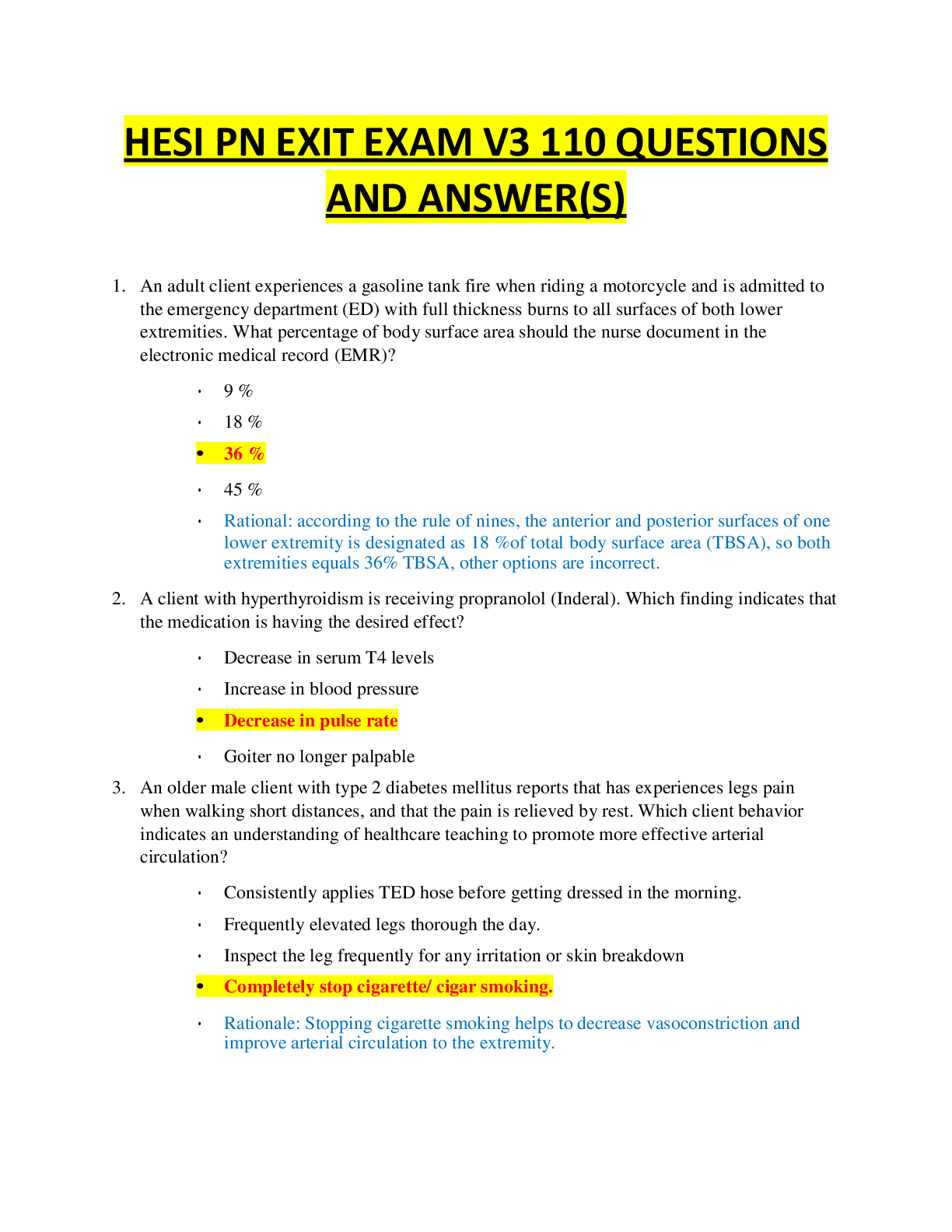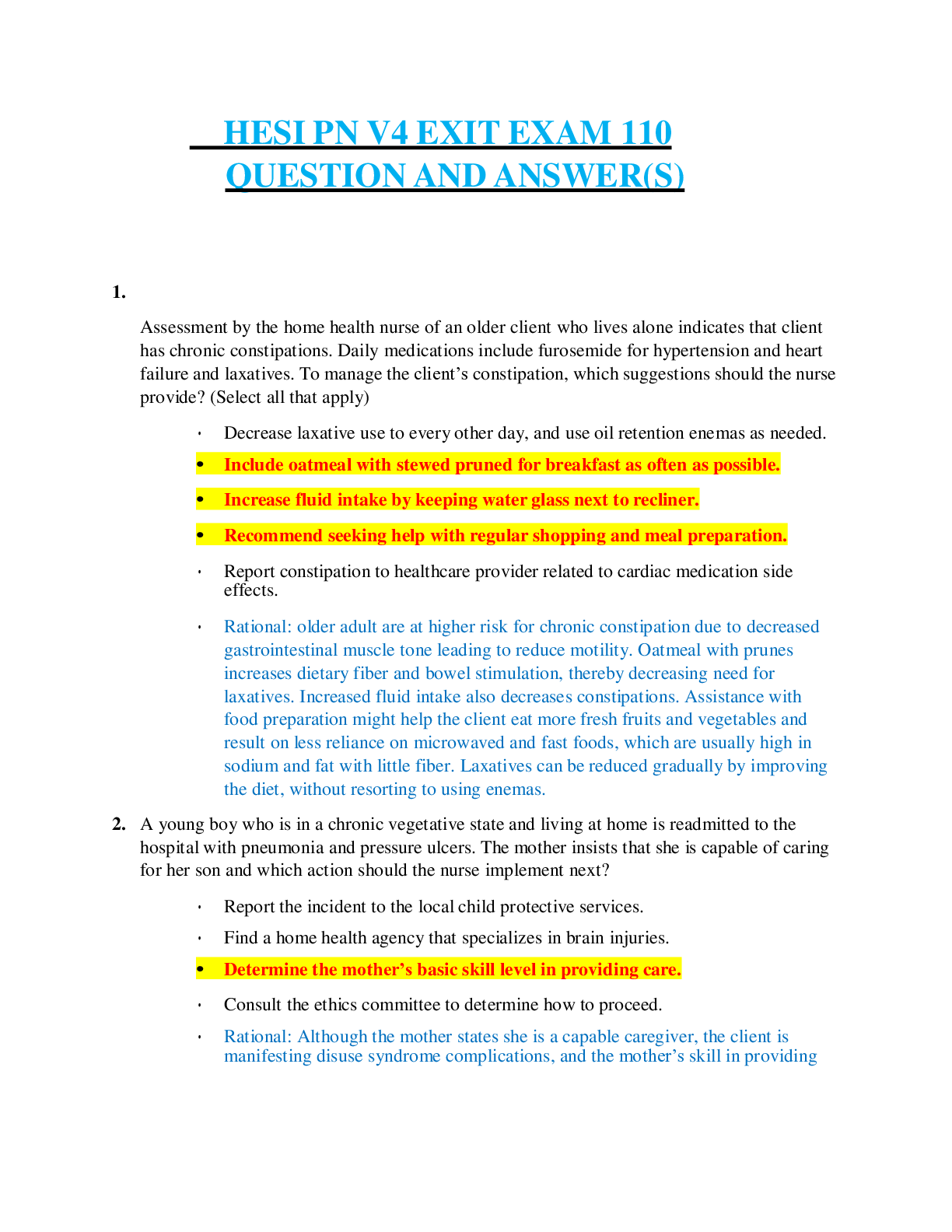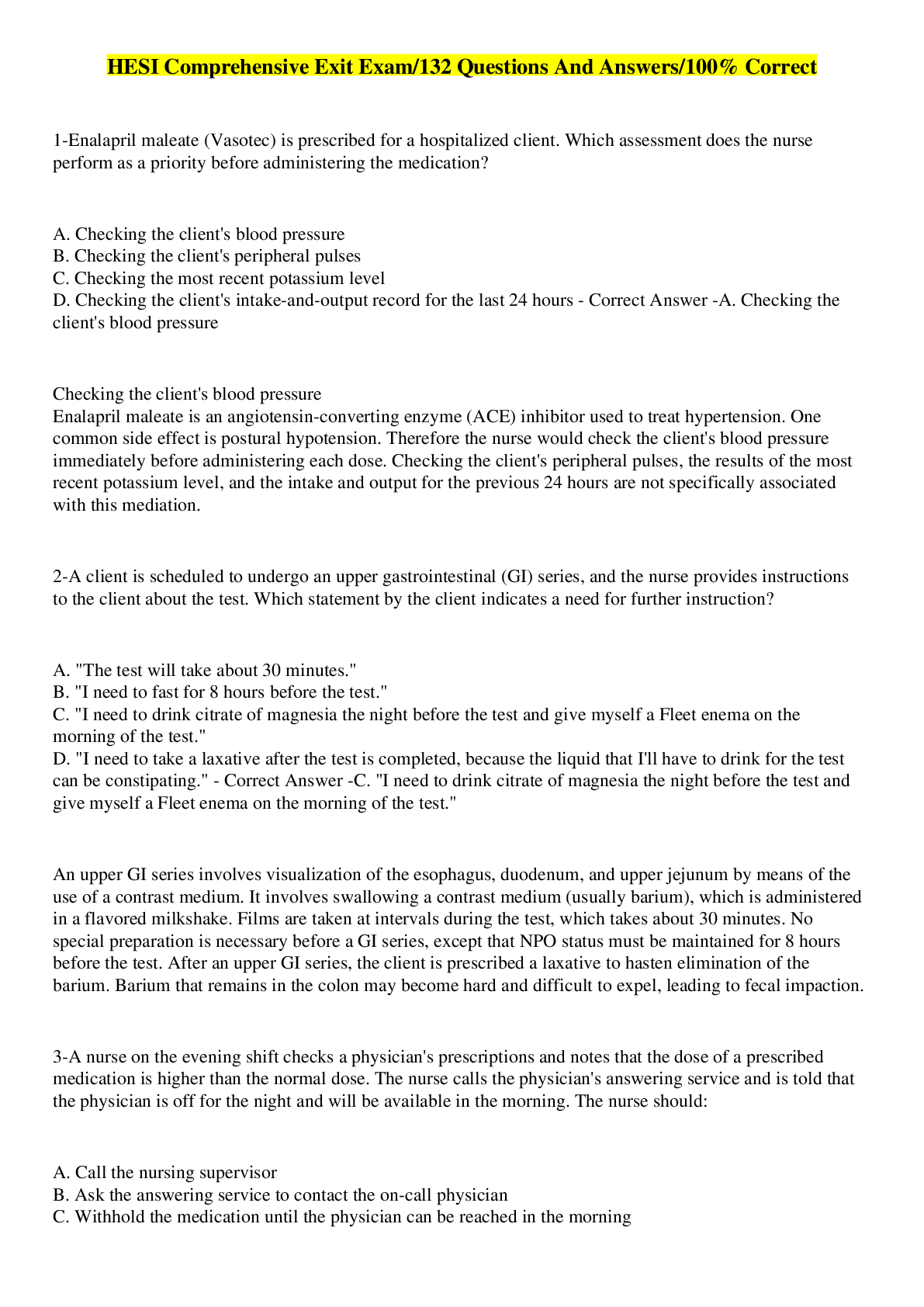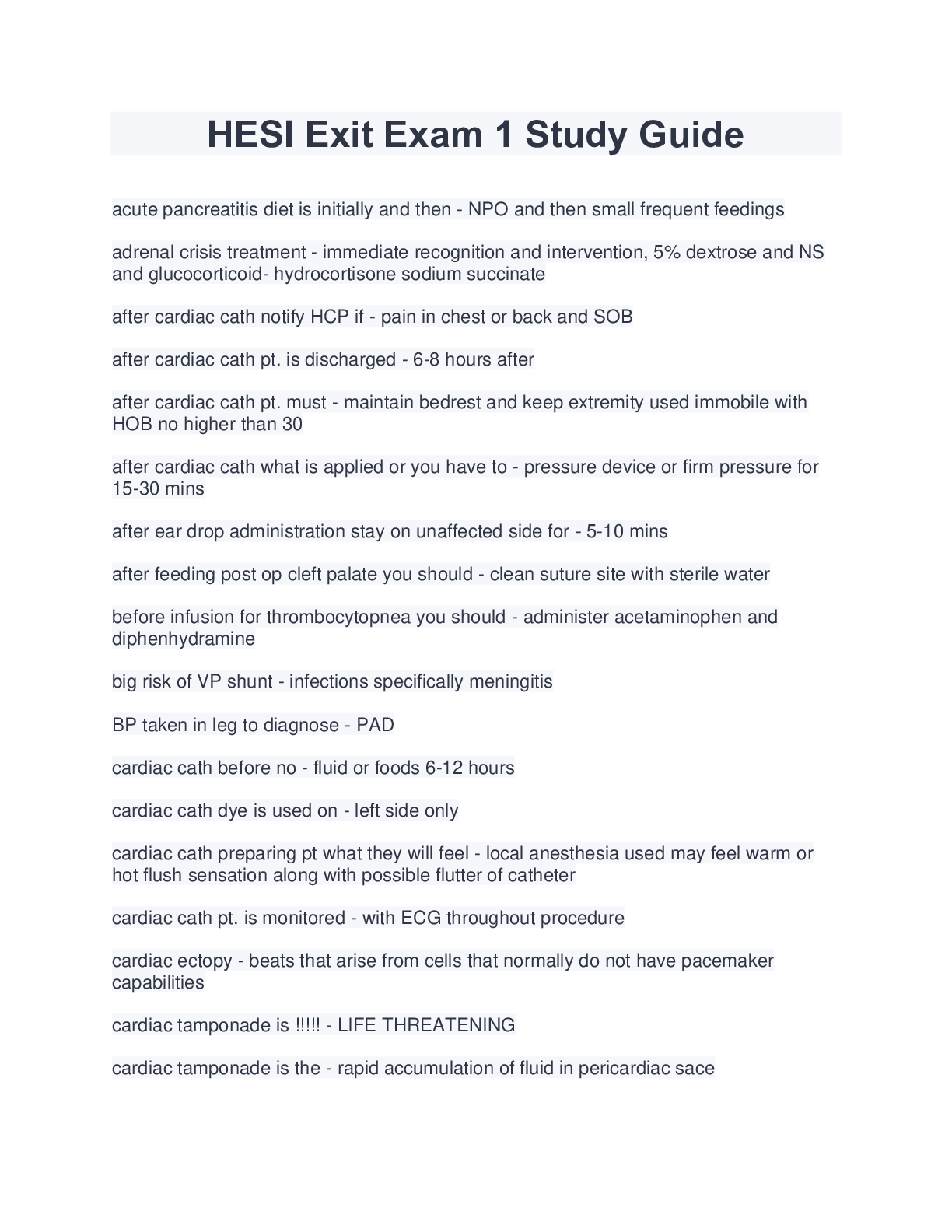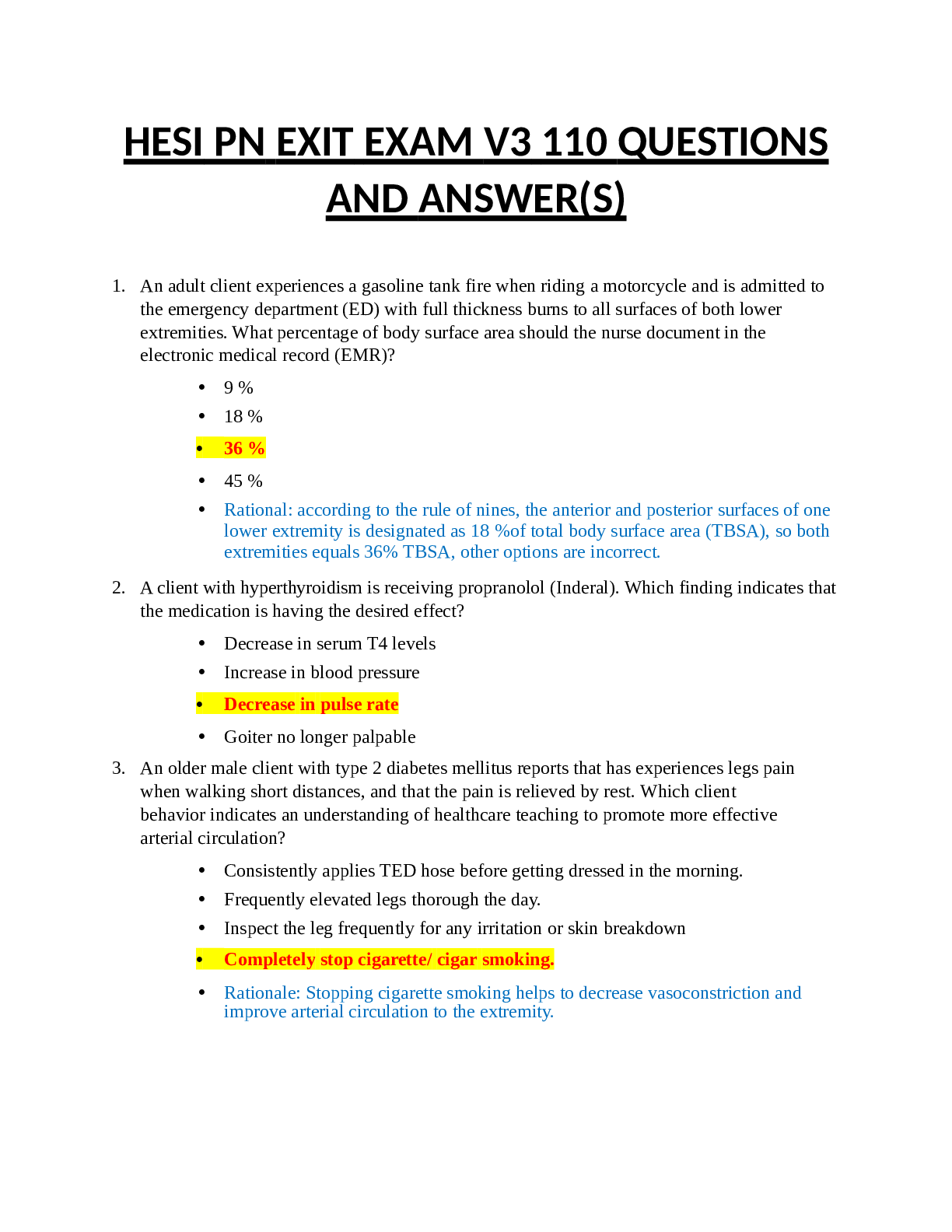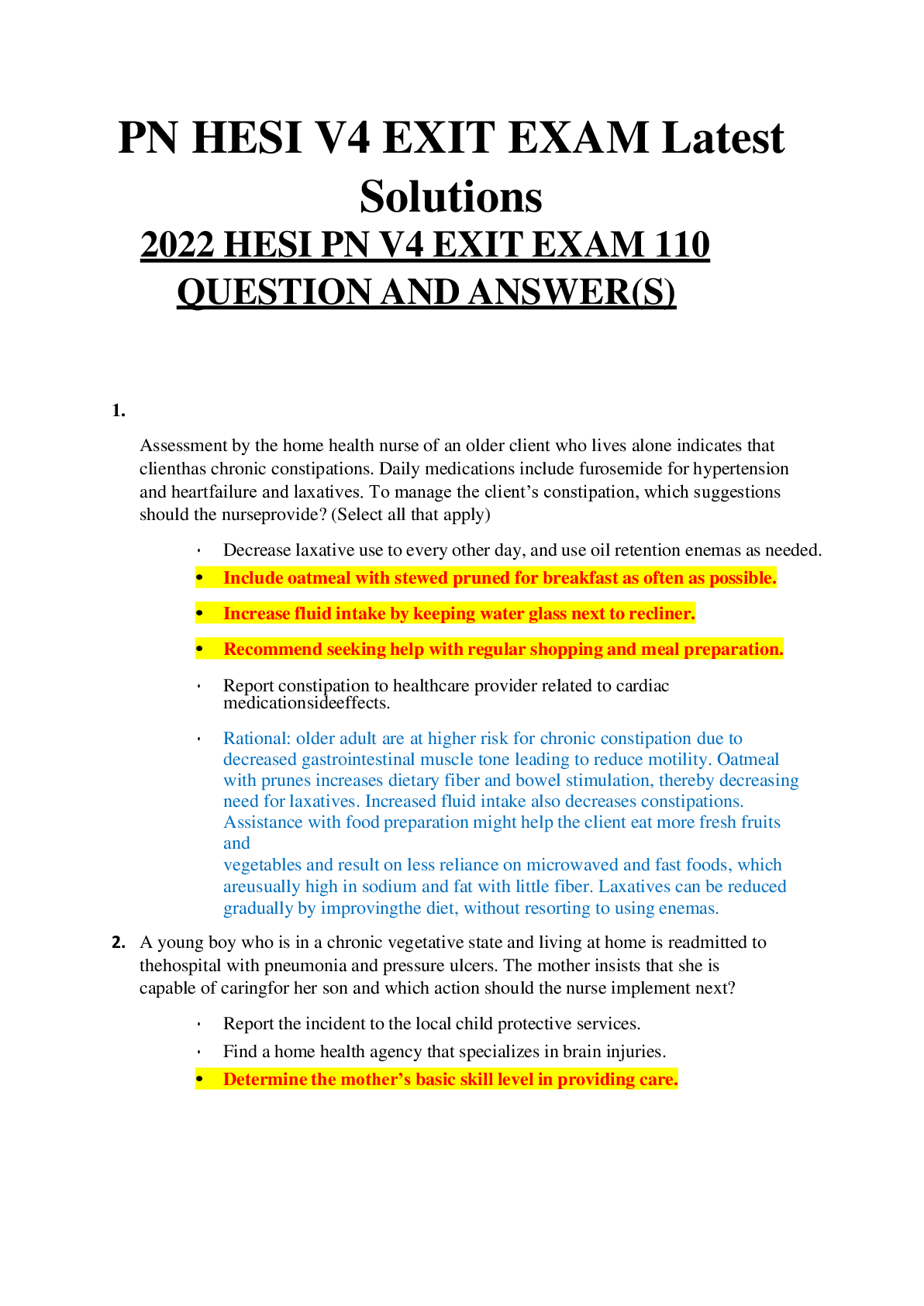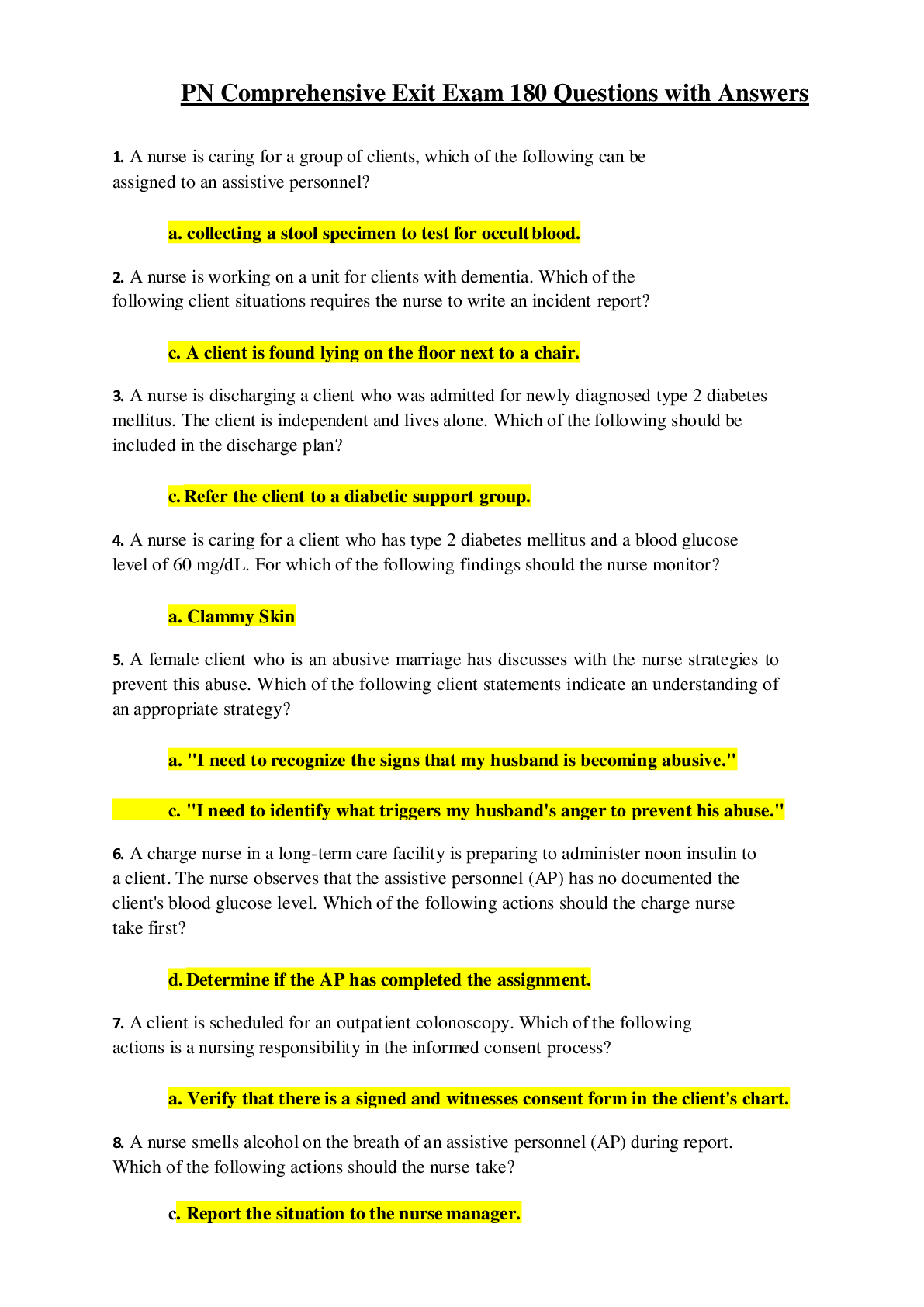*NURSING > HESI > HESI COMPREHENSION EXIT EXAM 1 OCRLatest Questions and Complete SolutionsOCRGRADED A (All)
HESI COMPREHENSION EXIT EXAM 1 OCRLatest Questions and Complete SolutionsOCRGRADED A
Document Content and Description Below
HESI COMPREHENSION EXIT EXAM 1 (A Graded) Latest Questions and Complete Solutions 1. A nurse is assigned to care for a client with chronic renal failure who is undergoing hemodialysis through an inter... nal arteriovenous (AV) fistula in the right arm. Which of the following interventions should the nurse implement in caring for the client? Select all that apply. Assessing the radial pulse in the right extremity Correct Using the left arm to take blood pressure readings Correct Drawing predialysis blood specimens from the left arm Correct Assessing the area over the AV fistula for a bruit and thrill each shift Correct Placing a pressure dressing over the site after each dialysis treatment Administering intravenous (IV) fluids through the venous site of the AV fistula as needed Rationale: Several precautions must be observed to ensure the function of an internal AV fistula. The nurse assesses the fistula, and the distal portion of the extremity, for adequate circulation; checks for a bruit and a thrill by means of auscultation or palpation over the access site; monitors the radial pulse in the extremity; and avoids taking blood pressure readings or drawing blood from the arm with the AV fistula. Venipuncture is avoided in the extremity bearing the AV fistula. Blood is never drawn from the AV fistula, and the AV fistula is not used for the administration of IV fluids. The AV fistula site is not covered with a pressure dressing after dialysis. Test-Taking Strategy: Think of the AV fistula as the client’s lifeline. Recalling that the nurse must assess the fistula for patency and protect the site from injury will help you identify the appropriate interventions. Review care of the client with an AV fistula if you had difficulty with this question. Level of Cognitive Ability: Applying Client Needs: Physiological Integrity Integrated Process: Nursing Process/Implementation Content Area: Adult Health Reference: Ignatavicius, D., & Workman, M. (2010). Medical-surgical nursing: Critical thinking for collaborative care (6th ed., pp. 1623, 1624). St. Louis: Saunders. Awarded 0.0 points out of 1.0 possible points. 2.ID: A nurse is evaluating outcomes for a client with Guillain-Barré syndrome. Which of the following outcomes does the nurse recognize as optimal respiratory outcomes for the client? Select all that apply. Normal deep tendon reflexes Incorrect Improved skeletal muscle tone Absence of paresthesias in the lower extremities Incorrect Clear sounds in the lower lung fields bilaterally Correct Po2 of 85% and Pco2 of 40 mm Hg Correct Rationale: Satisfactory respiratory outcomes include clear breath sounds on auscultation, clear mentation, spontaneous breathing, normal vital capacity, and normal arterial blood gases. The ABG results listed here — a Po2 of 85% and a Pco2 of 40 mm Hg — are normal. The presence of normal deep tendon reflexes, improved skeletal muscle tone, and absence of paresthesias in the lower extremities reflect improvement in the symptoms associated with Guillain-Barré but are not specific to a respiratory outcome. Test-Taking Strategy: Use the process of elimination and focus on the subject, optimal respiratory outcomes. Eliminate normal deep tendon reflexes, improved skeletal muscle tone, and absence of paresthesias in the lower extremities, because they are unrelated to the subject of the question. Review care of the client with Guillain-Barré syndrome and the expected respiratory outcomes of care if you had difficulty with this question. Level of Cognitive Ability: Evaluating Client Needs: Physiological Integrity Integrated Process: Nursing Process/Evaluation Content Area: Adult Health Reference: Lewis, S. L., Dirksen, S. R., Heitkemper, M. M., Bucher, L., & Camera, I. M. (2010). Medical- surgical nursing: Assessment and management of clinical problems (8th ed., p. 1586) St. Louis: Mosby. Awarded 0.0 points out of 1.0 possible points. 3.ID: A nurse on the telemetry unit is caring for a client who has had a myocardial infarction and is now attached to a cardiac monitor. The nurse, monitoring the client’s cardiac rhythm, notes the rhythm depicted in the image. Which of the following nursing actions should the nurse take? Calling the rapid response team Correct Preparing the client for cardioversion Asking the client to bear down and cough Preparing to administer diltiazem (Cardiazem) Incorrect Rationale: This pattern indicates ventricular fibrillation (VF). Clients who have sustained a myocardial infarction are at great risk for VF. With the onset of VF the client feels faint, then immediately loses consciousness and becomes pulseless and apneic. There is no blood pressure, and heart sounds are absent. The goals of treatment are to terminate VF promptly and convert it to an organized rhythm. Because defibrillation is the immediate treatment, the nurse must call the rapid response team and initiate cardiopulmonary resuscitation. The client would not be able to bear down or cough. Cardioversion is a synchronized countershock that may be performed in emergencies for unstable ventricular or supraventricular tachydysrhythmias or electively for stable tachydysrhythmias that are resistant to medical therapies such as the administration of diltiazem (Cardiazem). Test-Taking Strategy: Focus on the cardiac rhythm. Knowing that the rhythm is VF will assist you in determining the correct nursing action. Review this life-threatening rhythm if you had difficulty with this question. Level of Cognitive Ability: Applying Client Needs: Physiological Integrity Integrated Process: Nursing Process/Implementation Content Area: Adult Health Reference: Ignatavicius, D., & Workman, M. (2010). Medical-surgical nursing: Critical thinking for collaborative care (6th ed., p. 750). St. Louis: Saunders. Awarded 0.0 points out of 1.0 possible points. 4.ID: A nurse developing a plan of care for a client with a spinal cord injury includes measures to prevent autonomic dysreflexia (hyperreflexia). Which of the following interventions does the nurse incorporate into the plan to prevent this complication? Keeping a fan running in the client’s room Keeping the linens wrinkle-free under the client Correct Limiting bladder catheterization to once every 12 hours Avoiding the administration of enemas and rectal suppositories Rationale: The most frequent causes of autonomic dysreflexia are a distended bladder and impacted feces in the rectum. Straight catheterization should be performed every 4 to 6 hours, and the Foley catheter should be checked frequently to prevent kinks in the tubing. Constipation and fecal impaction are other causes, so maintaining bowel regularity is important. Other causes include stimulation of the skin by tactile, thermal, or painful stimuli. The nurse renders care in such a way as to minimize risk in these areas. Test-Taking Strategy: Use the process of elimination. Remember that autonomic dysreflexia is caused by noxious stimuli of the bowel, bladder, or skin. With this in mind, you can easily eliminate each of the incorrect options. Review the measures to minimize the risk of autonomic dysreflexia if you had difficulty with this question. Level of Cognitive Ability: Applying Client Needs: Physiological Integrity Integrated Process: Nursing Process/Planning Content Area: Adult Health Reference: Swearingen, P. (2008). All-in-one care planning resource: Medical-surgical, pediatric, maternity & psychiatric nursing care plans (2nd ed., p. 336). St. Louis: Mosby. Awarded 1.0 points out of 1.0 possible points. 5.ID: A nurse provides home care instructions to a client who has been fitted with a halo device to treat a cervical fracture. Which statement by the client indicates the need for further instruction? “I need to get more fluids and fiber into my diet.” “I should cut my food into small pieces before I eat.” “I need to put powder under the vest twice a day to prevent sweating.” Correct “I have to check the pin sites every day and watch for signs of infection.” Rationale: The client should cleanse the skin under the lambs-wool liner each day to prevent rashes or sores. Powder or lotions should be used only sparingly or not at all because they may cake, resulting in skin irritation. The client should increase intake of fluid and fiber to help prevent constipation. Food should be cut into small pieces to facilitate chewing and swallowing. The client should also use a straw for drinking. The pin sites should be checked daily for signs of infection. Test-Taking Strategy: Use the process of elimination and note the strategic words “need for further instruction,” which indicate a negative event query and the need to select the incorrect client statement. Recalling that powders or lotions may cake, resulting in skin irritation, will direct you to the correct option. Review teaching points for the client with a halo device if you had difficulty with this question Level of Cognitive Ability: Evaluating Client Needs: Physiological Integrity Integrated Process: Teaching and Learning Content Area: Adult Health Reference: Ignatavicius, D., & Workman, M. (2010). Medical-surgical nursing: Patient-centered collaborative care (6th ed., p. 1000). St. Louis: Saunders. Awarded 1.0 points out of 1.0 possible points. [Show More]
Last updated: 1 year ago
Preview 1 out of 35 pages
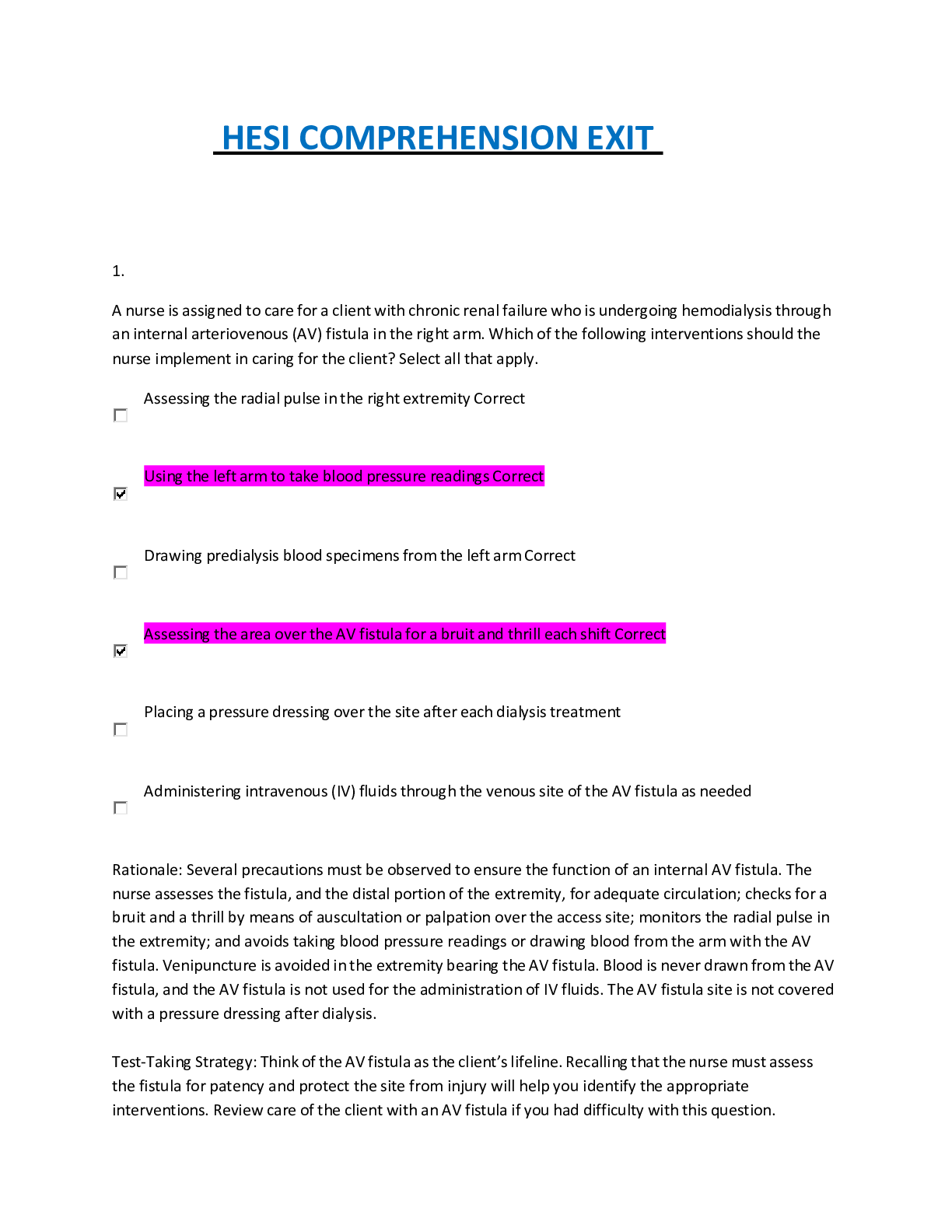
Reviews( 0 )
Document information
Connected school, study & course
About the document
Uploaded On
Jun 07, 2021
Number of pages
35
Written in
Additional information
This document has been written for:
Uploaded
Jun 07, 2021
Downloads
0
Views
31


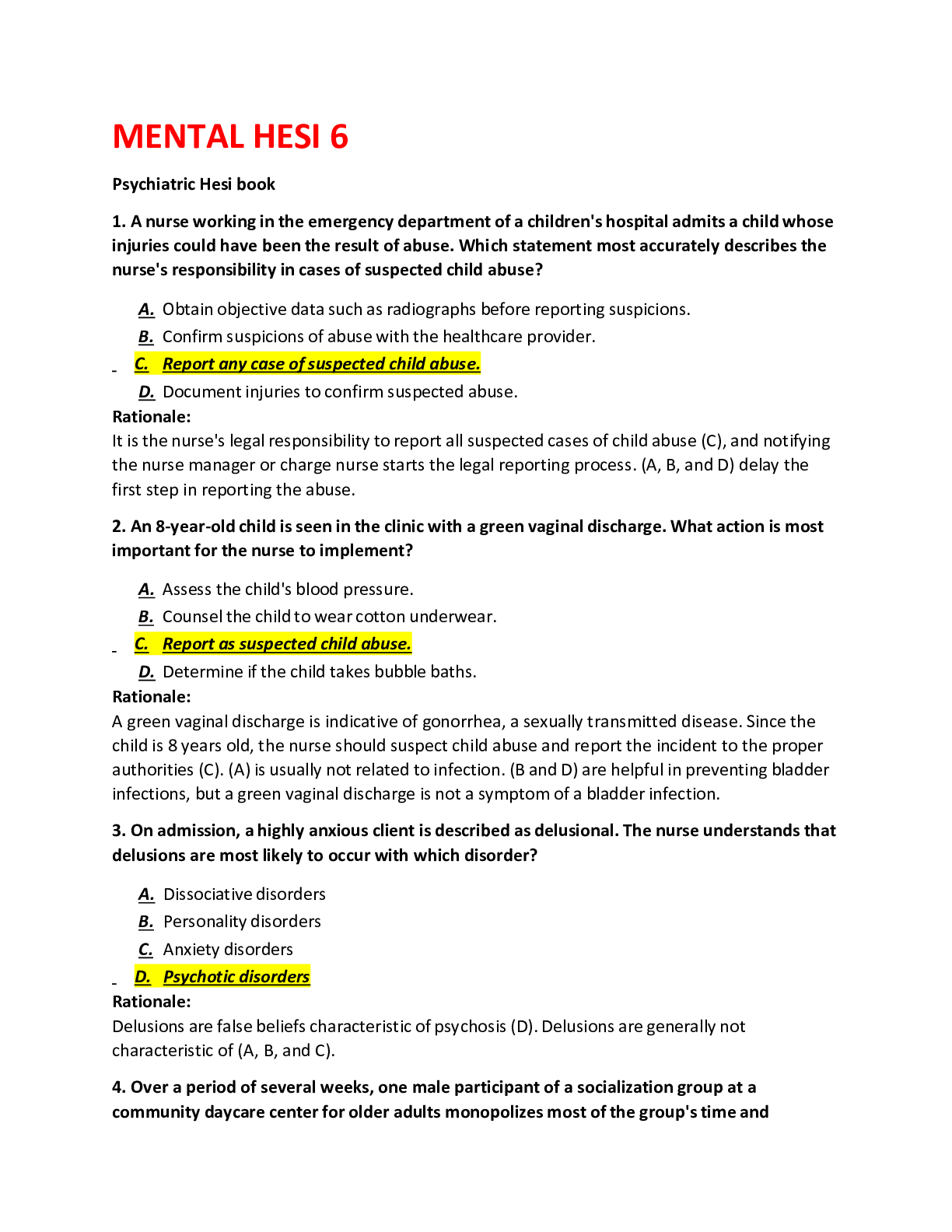
.png)
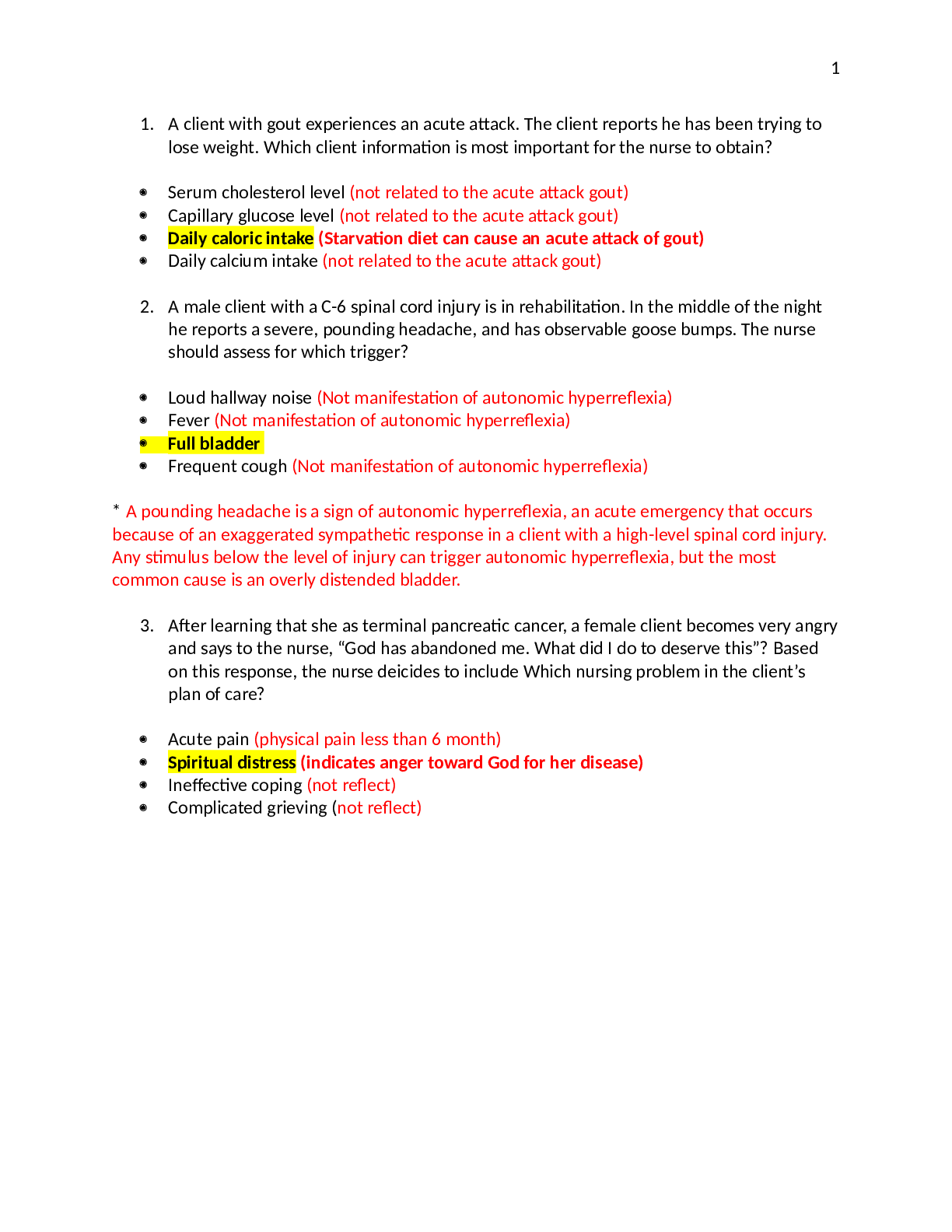
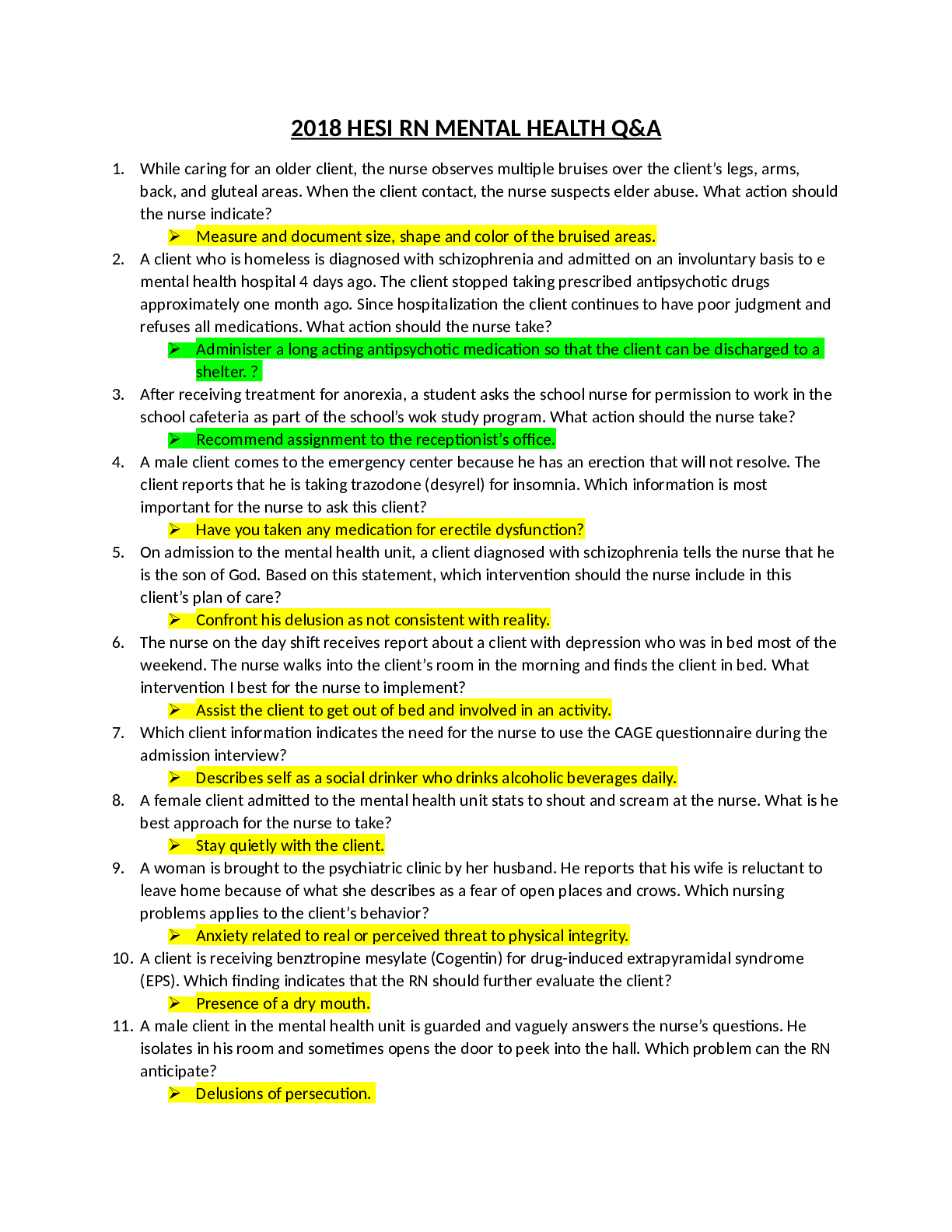
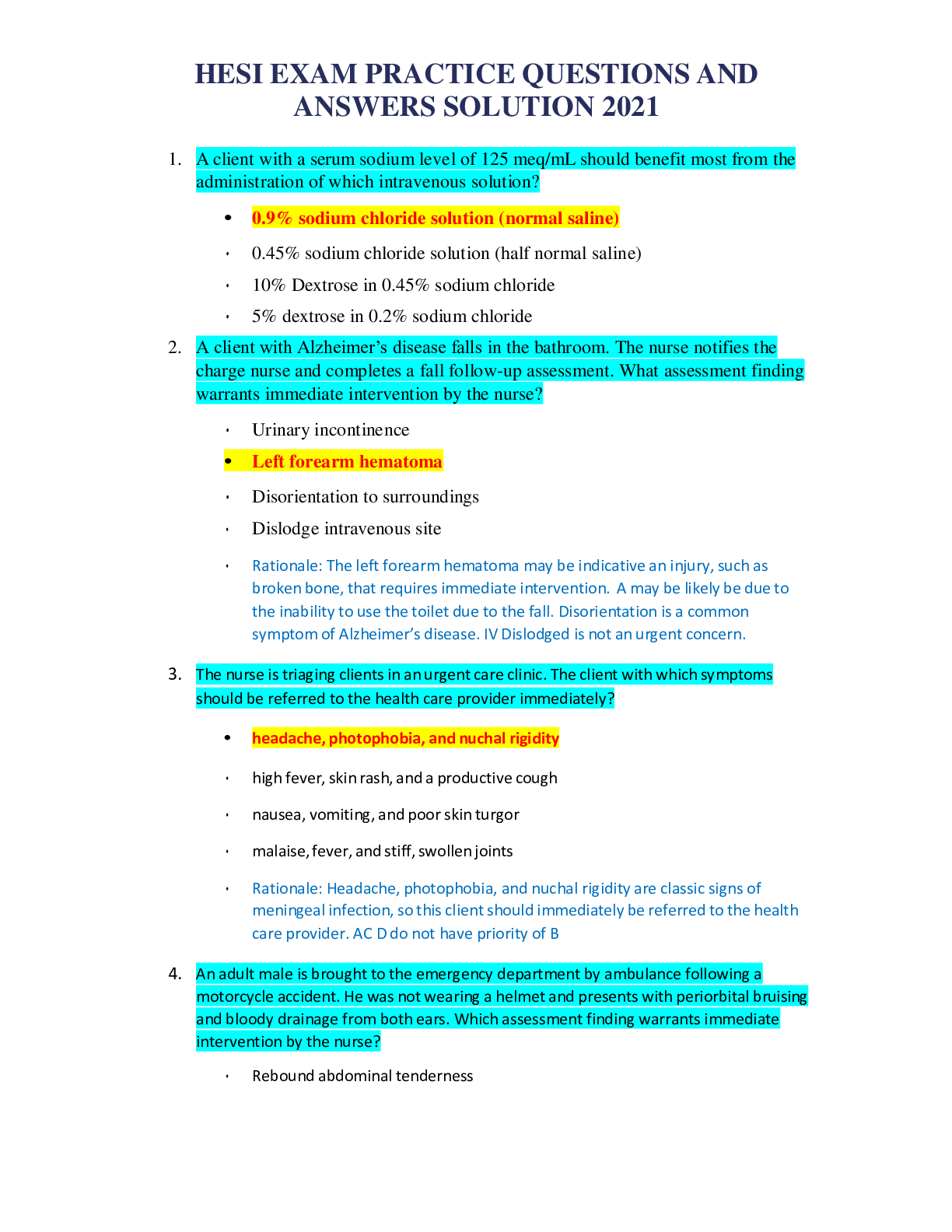
.png)

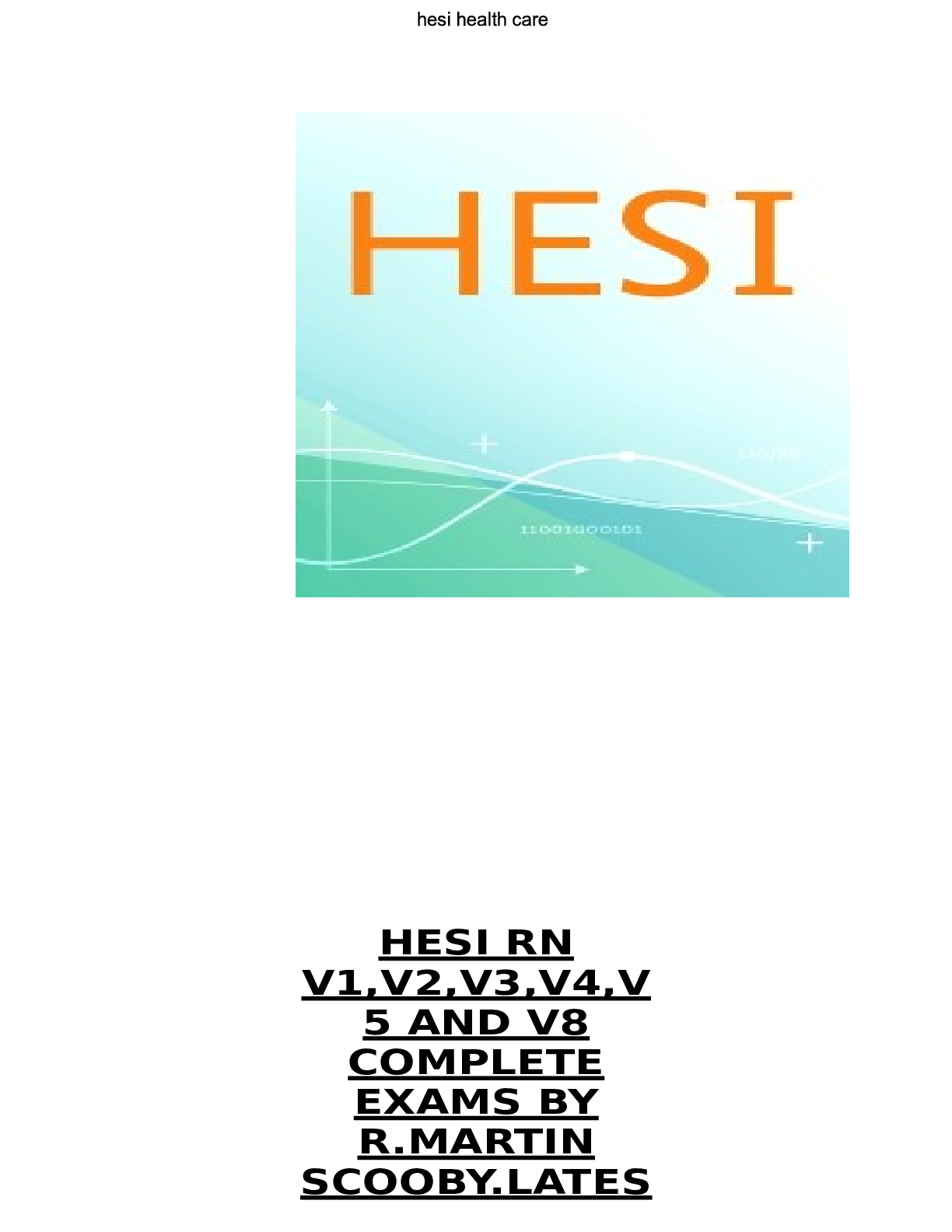
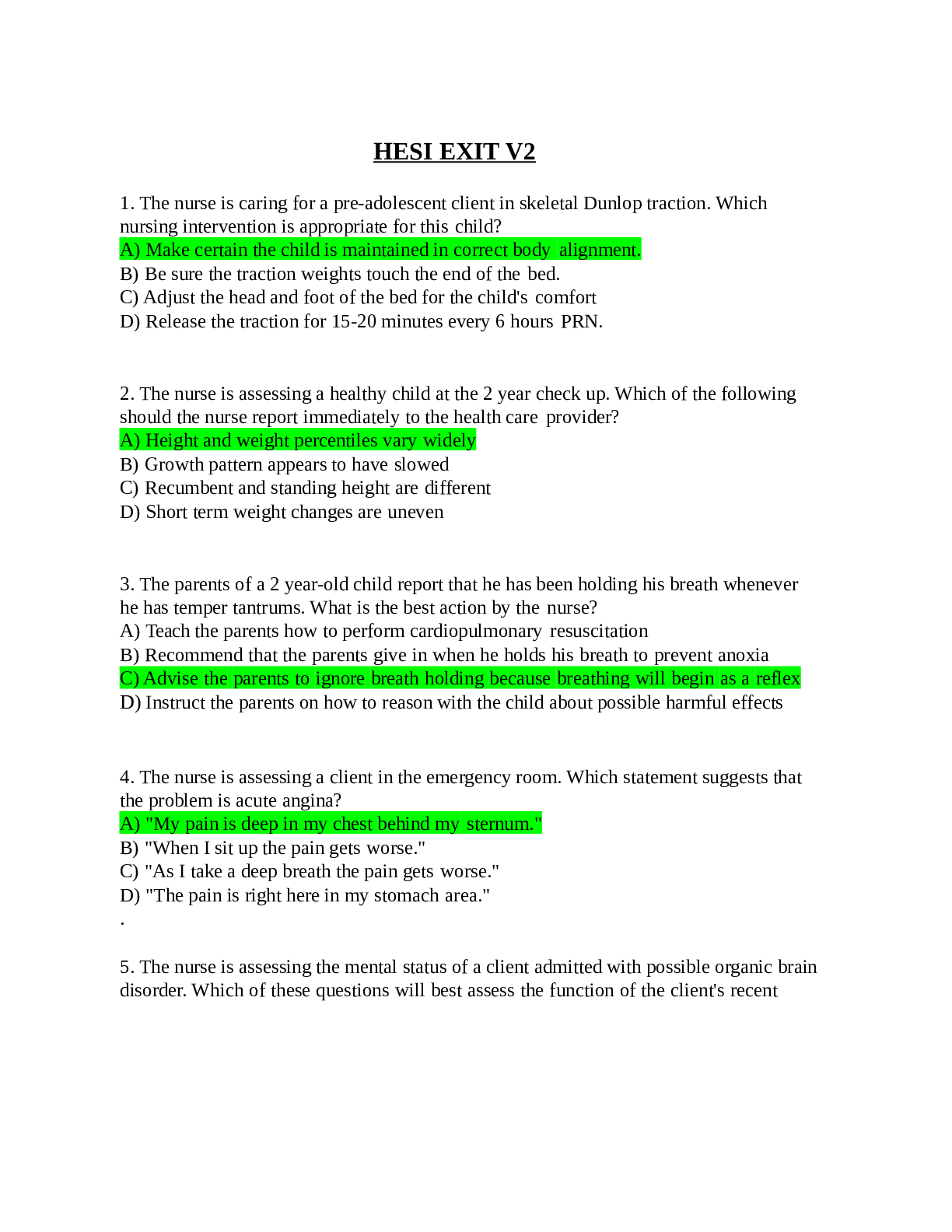
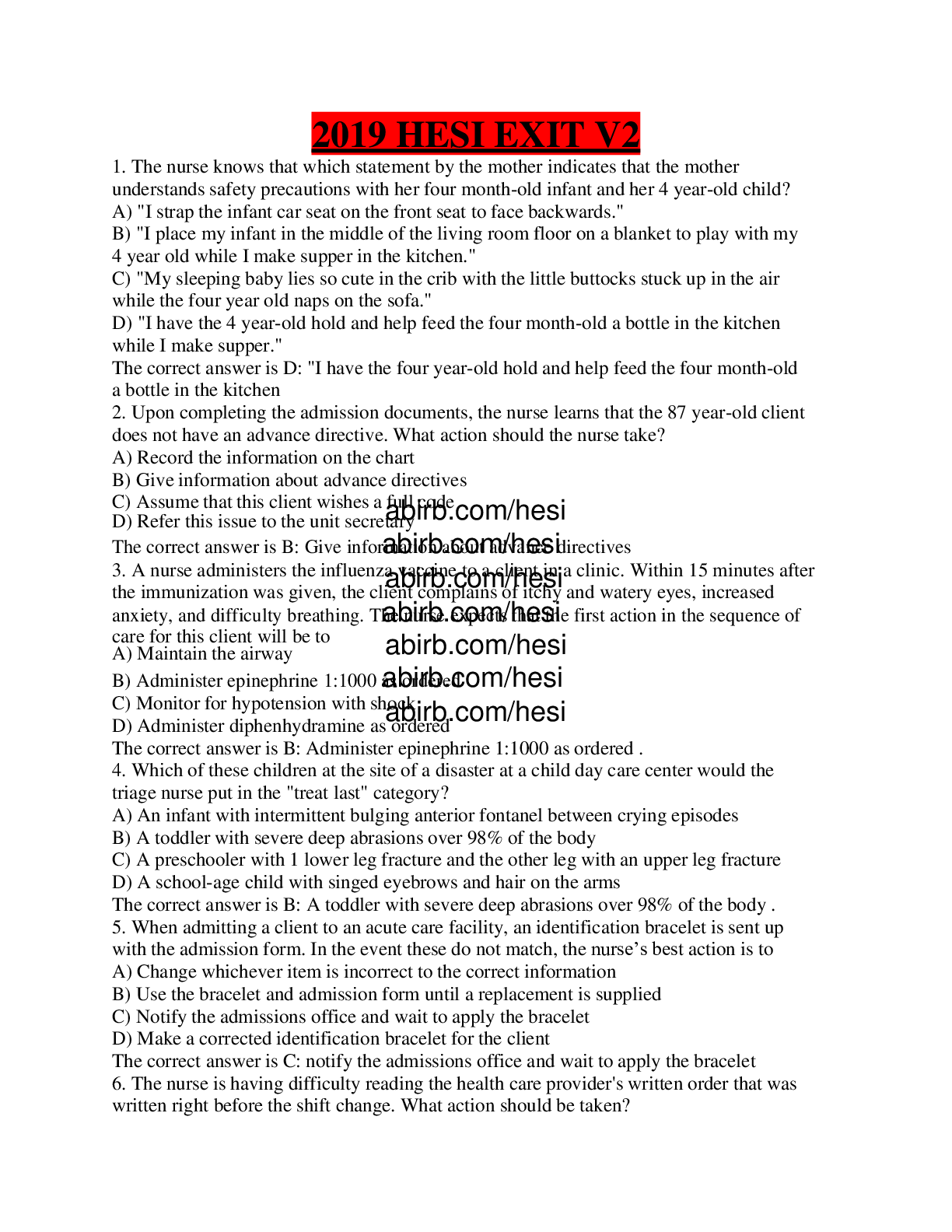
.png)
